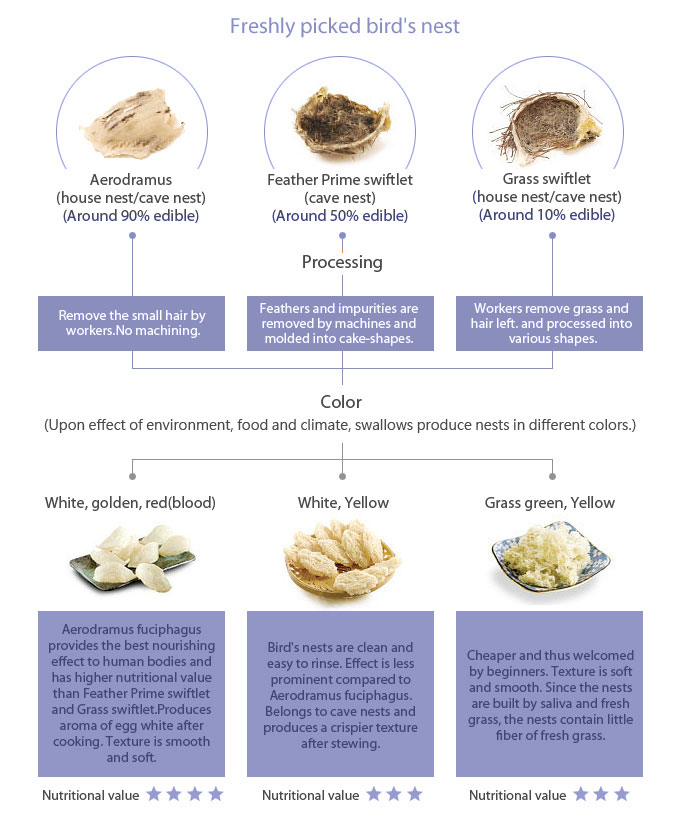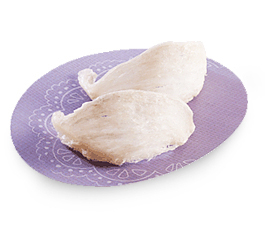Knowledge
What is Bird´s Nest?
Bird´s Nest comes from the saliva of swallows. Basically they are made of the saliva of Apodidae swiftlet and the other swiftlet under the same type. In brief, there are around 90 types of swallows and not all swallow saliva is edible. Those swallows that often bring branches, straw and soil to build nests which are definitely not edible. Edible nests are made of saliva of swiftlet, Feather Prime swiflet or Grass swiflet.

Country of Origin
Origins of bird´s nests are spread in Southeast Asia, including Indonesia, Thailand, Vietnam and Malaysia etc. Different bird´s nests have different textures. |
House nest is the most common variety in Indonesia with less impurities and cleaner. Texture is smoother and softer. Indonesia is the origin of highest production volume and supplies about 80% of bird´s nest in Hong Kong. |
 |
Thai bird´s nests are thicker, higher density and firmer in texture. It takes more time in soaking and stewing. Since production volume is small, the prices are higher. |
 |
More Feather Prime swiflet nest products, usually swiftlet processed into cakes and prices are low. Since instant food is usually produced with bird´s nest cakes, there is less and less dry bird´s nest cakes sold on the market and prices are thus increasing |
 |
Quality is high with stronger taste and aroma after stewed as compared to others, but supply is very limited. |
Classification
Bird´s nests are divided into the two following major categories:(1) House Nest
Swallow builds nest inside a house called swiftlet. House roof is made of wood. The internal setting of the house imitates the temperature, luminosity and humidity of natural caves. Average temperature is 28°C to 30°C and humidity lies between 89% and 90%, environment is humid and dark. Swallows leave the swiftler house in the morning to look for food outside until evening. Since environment is ideal, there is little impurities and feathers in the bird´s nest and it is cleaner with more complete shape like a boat or a spoon. According to swiftlets´ color they can be divided into white, yellow and red (blood). White nests are softer and smoother while golden nests and red (blood) nests are crispier in texture.
New Knowledge of the Red (Blood) & Yellow Bird´s Nests before purchase
Up to now, there are many controversies over the formation of the Red (Blood) Bird´s Nest. It is believed that the formation of the Red (Blood) Bird´s Nest is because the swallows have consumed several kinds of food. There are different arguments in academia whether this is due to the enzyme of the food, bacteria of the food, chemical reaction or heat in the food. It is also believed that if the swallows´ feces are collected from the swiftlet house and placed next to the bird´s nest for a week (during that the bird´s nest will be stored in plastic container and separated from the swallows´ feces by the gauze) can also formulate the Red´s nest. We have consulted many industry practitioners and believed that over 90% of Red (Blood) Bird´s Nest sold in the market (including us) are formatted based on the latter rationale.
The process of the color formulation of Red (Blood) Bird´s Nest: Bird´s nest will turn white color into yellow color. Then, yellow bird´s nests turn into orange and finally into red (blood bird´s nest). The content of nitrite in yellow bird´s nests will be higher than white bird´s nests, but lower than red (blood) bird´s nests.
After random sampling for the content of nitrite in our red (blood) bird´s nests, the results are shown below:
| HK JEBN red (blood) bird´s nest | ||
| Dried bird´s nest 2600 ppm |
Rinsed and soaked bird´s nest 88.1 ppm |
Stewed bird´s nest 33.6 ppm |
It shows that after rinsing, soaking and stewing processes, the content of nitrite in bird´s nest drops significantly.
Above result is the average amount based on the testing of the mixture of our few selected piece of red (blood) bird's nest products which are blended together. The content of the nitrite in red (blood) bird's nest of each piece will be varied from 1000ppm to 10000ppm etc.
Acceptable daily intake (ADI) of nitrite is 0.07mg per 1kg body weight. For instance, a 60kg adult will exceed his ADI of nitrite only if one consumes 125g dried red (blood) bird's nests a day. In other words, it means that only if consuming at least 16 pieces of red (blood) bird's nests a day will an adult exceed the standard, assuming the weight of 1 piece equal to 0.2 tael (7.56g).
Since the content of nitrite in bird´s nests is not listed in Hong Kong regulations, we list out the content of nitrite in meat products here for reference.
| Pork and poultry products | |
| Non-heat treated 200 ppm |
Heat-treated < 125 ppm (within acceptable range) |
Remarks:
1. Source: Preservatives in Food Regulation (Cap. 132BD), Schedule 1
2. 1 ppm=1/1,000,000; Example:1 ppm means there is 1 mg of nitrite in 1 kg of bird's nests
(2) Cave Nest:
Swallows build their nests on mountain caves, rock caves and cliffs. Affected by natural climate and environment, the texture tends to be stiffer and harder, with a darker color and less appealing appearance. There are more impurities in cave nest and it takes longer time to soak, giving a crispier texture.
Varieties
Bird´s nests sold on the market include natural bird´s nest cups, strips, threads, crumbles and scattered pieces processed into cakes of different shapes. There are three major types:

Harvesting Period and Grading
Usually, the harvesting period of bird´s nest is separated into several months between the harvesting periods. The nests built during the first period, which is from November to March every year, are called the first-tier nests. The second period and third period follow.| 1st tier Nov-Mar |
With surplus rainfall, reproduction is promoted in small animals. Aerodramus therefore gets sufficient food supply and this strengthens their bodies, thus lead to increase saliva secretion. Impurities are extremely little. The nests are big and thick and volume is the largest when soaked. The 1st tier nests are the most precious. |
| 2nd tier Apr-Jun |
The second period for building nests. The production sites start entering dry season and the source of food for Aerodramus is reduced. Nests built are looser and the threads are less closely grouped and less dense. The shape and volume after soaking is not as good as the 1st tier. |
| 3rd tier Jul-Oct |
During the season of extreme dryness, Aerodramus are in their worst body condition. Saliva secretion is slow and feathers fall off quickly, thus impurities (such as feathers) increase. Smaller volume when soaked. |
Functions

"Ben Cao Bei Yao (Complete Essentials of the Materia Medica)" composed by Wang Ang in 1694 during the Qing Dynasty and "Ben Jing Feng Yuan (Origin of Materia Medica)" composed by Zhang Lu in 1695 have shown that centuries ago, Chinese people have already approved the effect of bird nests and apply them in disease treatment. From then on, from 1757 to 1871, a number of scholars and experts have explained in details in "New Compilation of Materia Medica", "Ben Cao Qiu Zhen (The truth of Materia Medica)" and "Notes on Compendium of Materia Medica" the benefits of bird´s nest, proving that it is a previous food with treatment effect. Among them, as in "Notes on Compendium of Materia Medica", bird´s nest has "sweet taste and is mild and calm in nature, greatly boosts internal fluids and lungs, decreases phlegm and stops coughs, nourishes as well as detoxifies. Sacred medicine for treatment of tiredness and weakness".
According to an article entitled "A Study of Bird´s Nest" by Professor Jiang Run Xiang and Mr. Guan Pei Sheng in "Ming Pao Monthly Magazine" (1985, issue 231), after thorough study, it was proved that as early as Ming Dynasty (1536), there were written records about bird´s nest in Huang Zhong's "Hai Yu". In 1596, Tao Ben Jun as described bird´s nest as luxurious food product in "Minzhonghai Cuoshu (the earliest diction on Marine Biology in China)". After over 100 years of consumption and clinical testing, finally a number of scholars have approved the medical treatment effect of bird´s nest and instead of just another kind of food, it was considered as a precious nourishing item.
According to Professor Jiang Run Xiang, references from various times in China have proved that bird´s nest heals the lungs and its effect is extremely prominent on terminal tuberculosis, stomach ulcer and coughing out blood, as well as promoting growth in human body.
In recent years, Professor Jiang has been researching and performing repeated tests on bird´s nest. In experiments on cells in-vitro, bird´s nest is discovered to contain mitogenic stimulation factor and Epidermal Growth Factor to stimulate cell growth and reproduction. It also promotes tissue growth in human beings, cell division and boosts cell immunity. These provide scientific evidence to prove that bird´s nest promotes growth, replenishes energy, speeds up recovery of diseases and improves resistance of body against diseases. The bio-active protein molecules possessed the following three properties:
1. Promotes regeneration of epidermal tissues;
2. Improves immunity of the body generated by cells;
3. Improves resistance of the body against X-rays.
Such bio-active protein molecules are readily absorbed by human bodies and differentiate bird´s nest protein from protein in other foods.
At the same time, the report also showed that the mitogenic stimulation factor in bird´s nests stays active around 80°C, but is lost upon boiling. This explained why bird´s nests need to be stewed over water in low heat. Bird´s nest can regulate hormones in human bodies, regulate body mechanism, strengthen the body, nourishes and give youthful complexion. It also provides energy to the body and promotes catabolism of fats.
Who should eat bird´s nests?
| Type of bird's nest | Suitable People Functions | ||
| White | All. Suitable for all seasons. Nourishes and gives youthful complexion. |
Regulates body mechanisms. Boosts immunity. |
Nutrition Analysis
Per 100g (100g=2.6 tael)| Ratio | Nutrients | |
| 49.9g | Multiple proteins | amide nitrogen, Mono-ammonia-nitrogen, Arginine, Humin, histidine ammonia-nitrogen, lysine ammonia-nitrogen, cysteine ammonia-nitrogen |
| 30.6g | Carbohydrates | hexosamine and similar mucins |
| 4.9g | Iron | |
| 2.5g | Inorganic salts Also referred to as lime nutrients |
Potassium, Sodium, Calcium, Magnesium, Sulphur, Phos-phorous, Silica and other micro-nutrients |
| 1.4g | dietary fibre | |
| 10.7g | others |
Food ingredients chart.
Serving Methods
According to recommendations of registered nutrition therapists, to cope with human body's ability to absorb pro-active protein molecules, regular doses should be taken continuously. Here are two serving methods for better results:(1) 1 to 2 bowls per week
(2) 1 to 2 tablespoons per day
